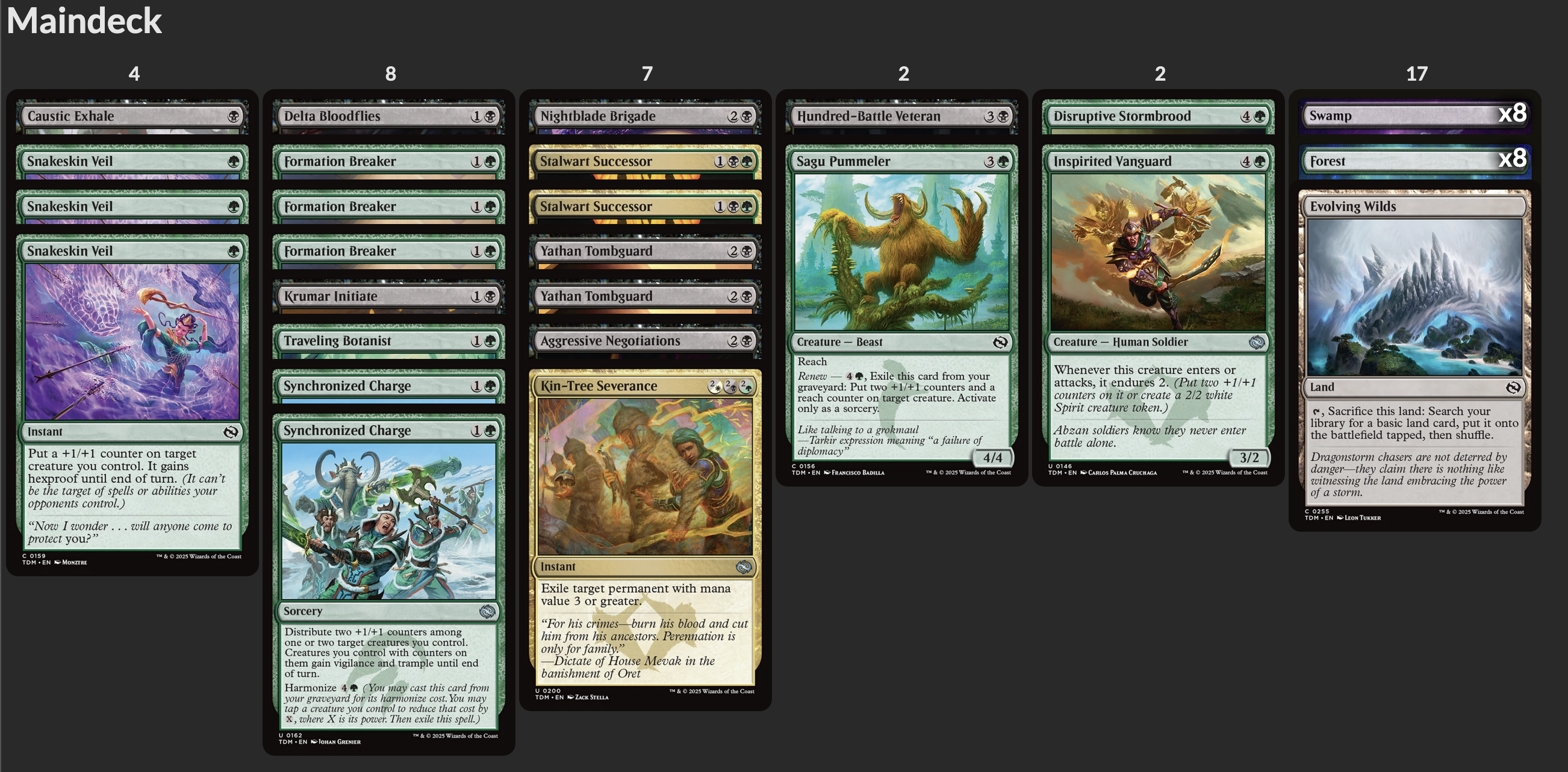A Recipe for Soup
04/10/2025
When most people think about "five-color soup" as an archetype in limited, they likely imagine a deck with many strong uncommons and rares across multiple colors. Surely, one must imagine, the benefit of playing four or five colors in your deck is that you get to play more strong cards.
And this isn't wrong, per se. But with recent trends in limited, there are quite a few powerful cards - enough that you don't need to play many colors to have many in your deck. Soup decks in Tarkir: Dragonstorm will undeniably be able to play higher quality cards on average, but not usually to that much of a greater degree than other, less colorful decks.
Flashy multicolor rares can be quite strong, but so are cheap, monocolor aggressive cards like
Synchronized Charge and Descendant of Storms. It's tempting to say that a card like Songcrafter Mage is stronger than those - but is that actually true? Ultimately it's difficult to compare the power of these cards, because they're strong in vastly different ways.By no means am I saying that having higher card quality isn't an important draw into playing multicolor soup. But I would like to propose that it isn't the only consideration, and in this set I would argue isn't even the primary one!
Part 1: The Draw to Soup
One of the most important things to consider when evaluating a Magic deck, in both limited and constructed, is figuring out exactly how it plans to spend its mana. In constructed, this generally involves examining key turns and play patterns; in limited, this involves examining what plays are available at each point in the curve, and importantly, what forms of smoothing and mana sinks there are.
Just playing 17 lands, with no card filtering or mana sinks, leaves you very prone to both flood and screw. This isn't to say that you can't win without tools to smooth out your mana; but certainly it will be an uphill battle against variance. So, one important question when thinking about how to build limited decks in a format is to figure out exactly what options you have available for smoothing.
One way to address the flooding issue is to simply be very aggressive. If you can actually consistently kill your opponent quickly, then you won't need to worry as much about what happens when the game goes long. And if your curve is low enough, you can maybe even cut a land to further combat flood.
Unfortunately, TDM is not a format that is particularly conducive to that, largely because there just aren't very many cheap aggressive cards. Sure, there are plenty of assertive Mardu cards; but there just isn't a high enough density of 2 drops to be able to consistently build a deck that is fast enough to combat the issue of flooding. It's not impossible (see below), but it is rare.
Another way you can deal with flooding is to have more mana sinks. This was the method that most decks in Aetherdrift employed - it felt like more than half of all of the cards in the set had an activated ability that you could spend more mana on.
Unfortunately, TDM is roughly the polar opposite - there are almost no mana sinks at all!
There are
renew cards and harmonize cards - but neither appear very much, neither are repeatable, and many of the cards are somewhat low impact. And other than those, basically the only cards that you could reasonably call "mana sinks" are the cycle of monuments.Now, the monuments are extremely strong, and their uniqueness in providing mana smoothing in multiple different ways - fixing your colors, while also being both a land and a spell at the same time - make them extremely important as well. But at the end of the day, there are still only five of them, all at uncommon; so it's really not a guarantee that you will see one, let alone one in your colors.
Finally, we come to the option that is most abundantly available in Tarkir: card draw. After all, the simplest way to ensure you continue to have spells to cast into the lategame is to simply draw more cards and see more spells. Most colors have access to some amount; but between
Focus the Mind, Roiling Dragonstorm, and Bewildering Blizzard, blue definitely has the highest quality and density of it.This, to me, is the crux of the issue: with very few mana sinks in the format, card draw becomes the primary option to combat flooding. And while card draw is powerful, it has costs - it's harder to play aggressive decks with many card draw spells, for example. And as you put more card draw spells into your deck, you're incentivized to play more mana sources to never get screwed. As you play more mana sources, it becomes easier to play more colors; and combined with the pressure to make your spells more individually impactful to better catch up on tempo after casting a card draw spell, this just pushes you further and further towards soup.
So to me, the draw towards soup is not the rares - anyone can play a a pile of rares. Instead, I see "soup" as an archetype defined by leveraging playing many mana sources to never screw; card draw to never flood; and individually powerful cards to leverage both.
Part 2: The Recipe
For the Maindeck:
19-21 mana sources
3-4 card draw
4-6 removal spells
3-4 cheap tempo plays
0-2 ramp
garnish with bombs
Instructions:
1. Combine ingredients in deck, shuffle thoroughly.
Part 3: Recipe Notes
Silliness aside, I do legitimately think that this is a good way to think about how to build soup decks. Specifically, I think it's quite important for every single card in your deck to fall into some category of "bomb" (by which I mean "powerful card that stands on its own", this can include many uncommons), card draw, cheap tempo play, removal spell, or mana source.
And it's also quite important to have a critical mass of each of these. Not enough card draw, and you're liable to flood; not enough tempo plays, and you're liable to be run over; not enough removal spells, and you're liable to die to your opponents' powerful cards. During drafts, you should be keenly aware of which of these roles you need more cards for - I might generally take
Bewildering Blizzard over Molten Exhale, but if I already have three card draw spells and only two removal spells, I'm probably going to prioritize Exhale higher.That said, I actually think that pure fixing is a commonly overrated part of soup decks. It certainly is important - but I generally don't want to be taking dual lands super early over powerful cards or card draw. In addition, I think that there are a lot of nonland options for fixing that are quite strong - monuments,
Sagu Wildling, and Dragonstorm Globe - so while dual lands will certainly contribute to your deck, it isn't strictly necessary to have many copies, unlike card draw.That said, as with most recipes, you don't have to follow these instructions precisely; they serve more as a guideline than a hard-and-fast rule. For example, if you have more monuments to spend mana on, you can skimp a little on card draw; if you have a lot of cheap removal, those can serve as your tempo plays; and of course exactly how many mana sources you want to be playing varies highly from deck to deck.
Some cards in the set also don't fit quite as neatly into these categories - two such cards that come to mind that I often find myself playing are
Temur Tawnyback and Monastery Messenger. Tawnyback is kind of a cheap tempo play, in that it blocks fairly well - but you can't rely fully on it in that slot, as it costs 3-4 mana. Similarly, it counts a little bit towards card draw, as it can help filter you through flooding, but very much does not replace actual card draw spells. Messenger, on the other hand, I would categorize under a weird kind of card draw - in that it can buy back your actual card draw spells, or any of your strong noncreature bombs.Part 4: Dragon Seasoning
A natural consequence of the structure of this set is that a lot of the individually powerful cards just happen to be dragons. From the
best rares, to great uncommons, you'll often find yourself naturally wanting to play quite a few dragons in the "bombs" slot of soup decks. And once you have 4+ dragons in your deck, all of the dragon synergy cards in the set gain a lot of value.The Exhale cycle at common are all good interaction spells that become notably stronger with dragons - but the differences aren't huge, so it's more of a nice bonus than a draw.
Dragonstorm Globe is the other payoff at common, and a very strong one at that. With how many strong 5 drops there are in this set, a Manalith with no other text would already be desirable in soup; but making your large stabilizing creatures even larger makes Globe actively strong.The real cream of the crop, though, is the Dragonstorm cycle at uncommon. Specifically, the
white, blue, and green ones are some of the strongest uncommons for soup once you have enough dragons. With 4+ dragons, the blue Dragonstorm serves as the best card draw; the white one as the best ground stabilizer; and the green one as the best ramp.Tying all of this together is one of the most important commons for soup:
Sagu Wildling. The card is already quite strong, as a very good modal land/nonland, but the potential for it to synergize with dragon synergies you are already predisposed to include in your deck makes it truly premium.Not every soup deck will end up with dragon synergies, and it certainly isn't necessary to build a good soup deck. But the dragons and payoffs are plentiful enough that most decks will dip into it at least a little; and that's enough to make all the dragon cards just a little bit stronger.
Part 5: Soup Sampler
To close this out, I'll provide a few examples of soup decks I've drafted. I've been doing pretty well in Arena Bo3 so far; and while I wouldn't say I'm forcing soup, I certainly am generallu struggling to find reasons to draft anything else.
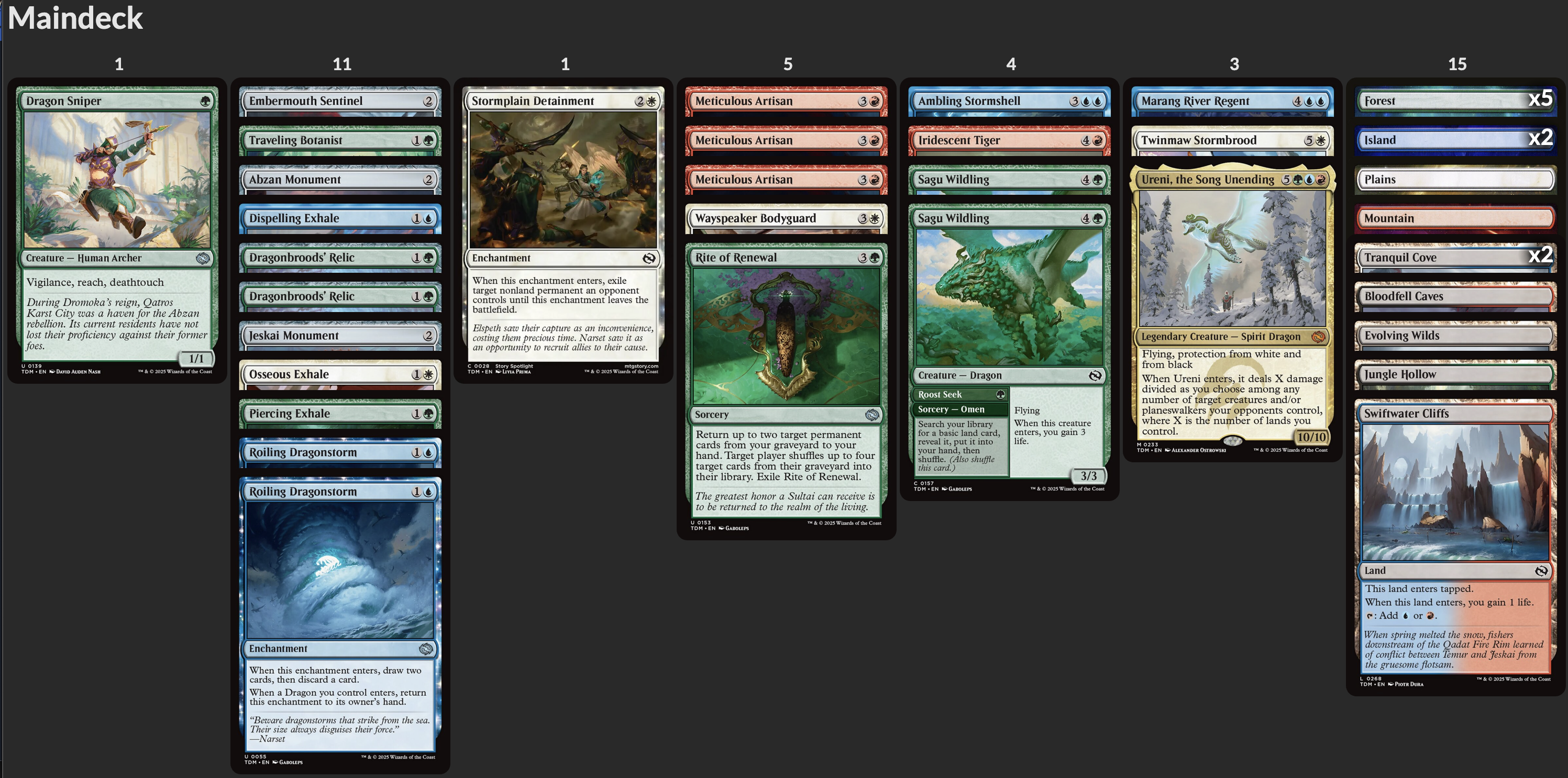
Meticulous Artisan can really shine in soup decks, especially ones that want to cast spells that cost 6+ (in this case 8, with Ureni and Relics) mana. This deck also showcased the power of the blue Dragonstorm; I didn't have any other card draw spells, but two Dragonstorms was certainly enough, especially with Relics to spend mana on.
17lands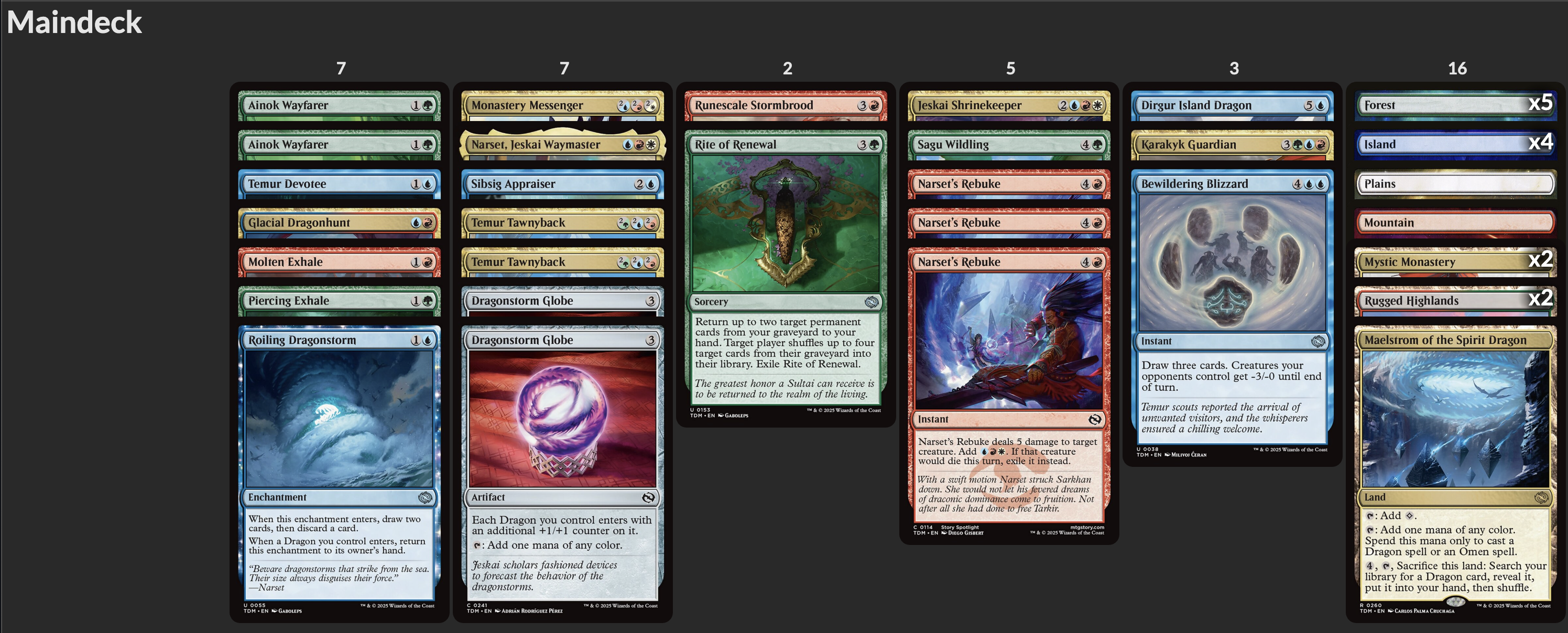
Who needs rares? Narset was very good for sure, but this deck is a good example of how soup can come together at common and uncommon, just with card draw, removal, and dragons.
17lands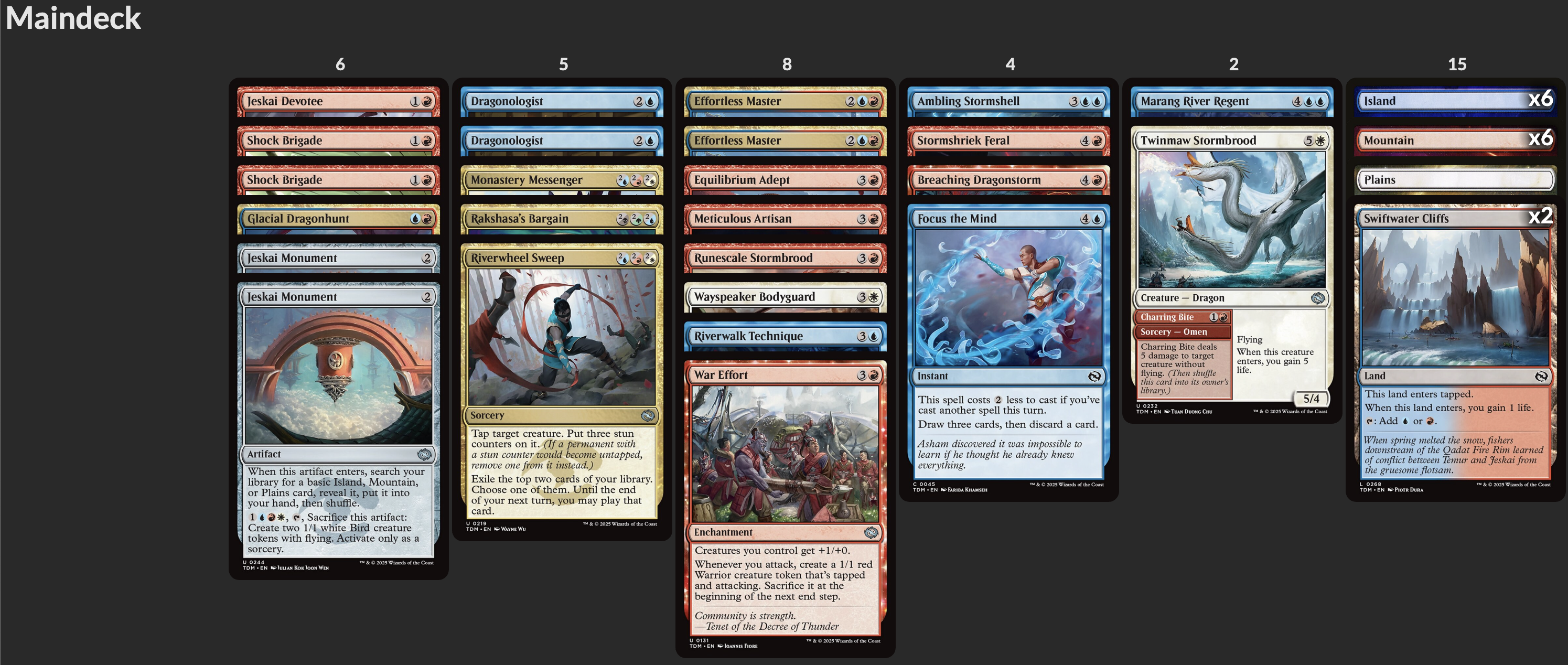
This might not look like a soup deck, but I would say it shares a lot of the same principles: card draw and removal, and mana smoothing from Monuments. It differs in that, since I didn't find as many strong topend cards (partially because of only being three colors), I felt the need to leverage some more aggressive cards like Shock Brigade.
17lands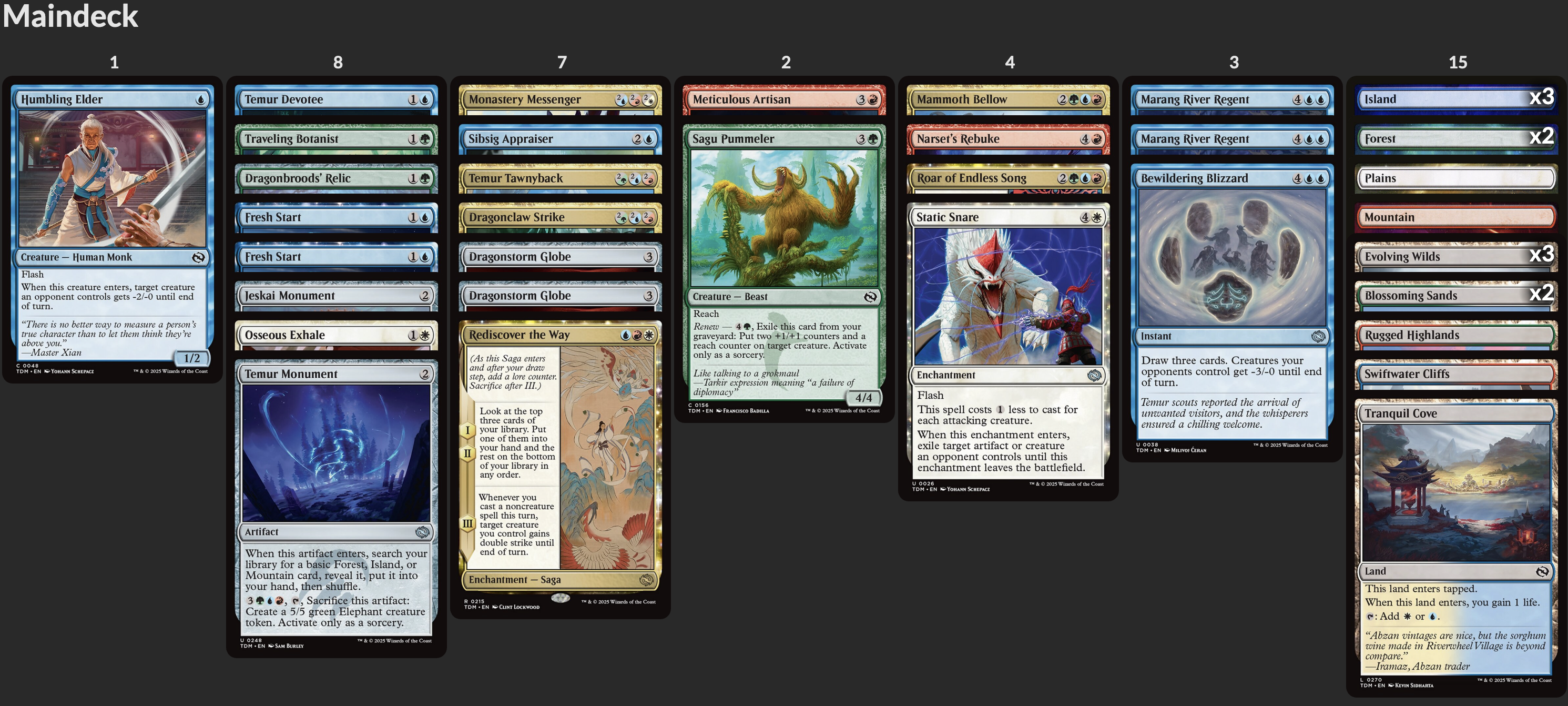
Probably one of my more absurd soup decks in terms of rare quality; two River Regents sure was something.
17landsBrief note: while none of these decks contain black cards, I've certainly enjoyred black as a color in soup as well. Temur is definitely the most common base, as there are more strong Temur bombs, and the red removal is on balance better (and less contested right now!) than the black removal, but there's nothing wrong with a Sultai base.
If you want to see any of the draft logs for these, or just look at more of my drafts, you can find my 17lands history here.
#FreePalestine | Consider donating to UNWRA or PCRF, supporting protesters locally, and educating yourself.

